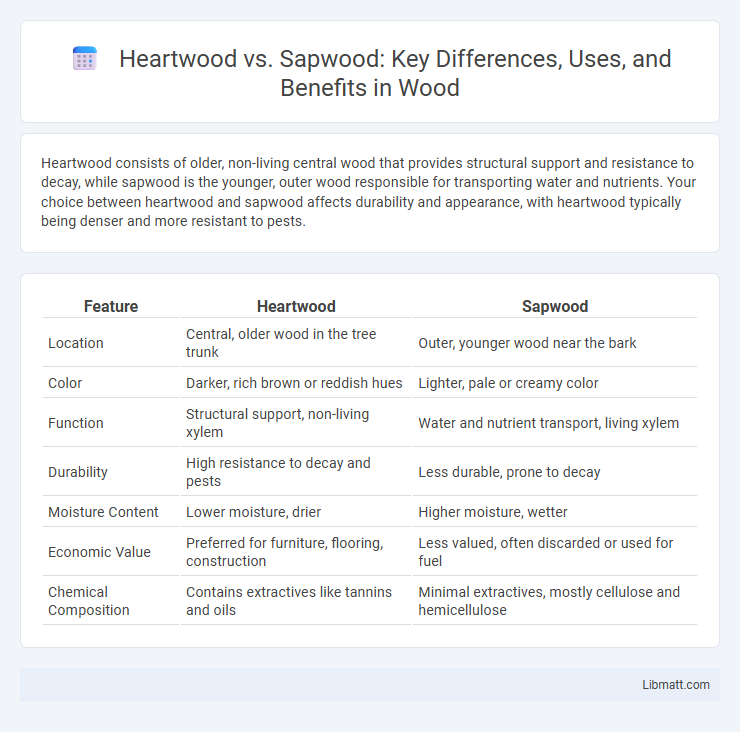Heartwood consists of older, non-living central wood that provides structural support and resistance to decay, while sapwood is the younger, outer wood responsible for transporting water and nutrients. Your choice between heartwood and sapwood affects durability and appearance, with heartwood typically being denser and more resistant to pests.
Table of Comparison
| Feature | Heartwood | Sapwood |
|---|---|---|
| Location | Central, older wood in the tree trunk | Outer, younger wood near the bark |
| Color | Darker, rich brown or reddish hues | Lighter, pale or creamy color |
| Function | Structural support, non-living xylem | Water and nutrient transport, living xylem |
| Durability | High resistance to decay and pests | Less durable, prone to decay |
| Moisture Content | Lower moisture, drier | Higher moisture, wetter |
| Economic Value | Preferred for furniture, flooring, construction | Less valued, often discarded or used for fuel |
| Chemical Composition | Contains extractives like tannins and oils | Minimal extractives, mostly cellulose and hemicellulose |
Introduction to Heartwood and Sapwood
Heartwood and sapwood are two distinct layers within a tree's trunk, each serving unique functions essential for the tree's growth and stability. Heartwood is the dense, central core of the tree, often darker and more resistant to decay due to its accumulation of chemical compounds, while sapwood is the outer, lighter-colored layer responsible for transporting water and nutrients from the roots to the leaves. Understanding the differences between heartwood and sapwood can help you choose the right type of wood for your woodworking or construction projects based on durability and appearance.
What is Heartwood?
Heartwood is the dense, inner core of a tree trunk, composed of older, non-living xylem cells that have become chemically distinct and more resistant to decay. It typically appears darker than the surrounding sapwood due to the accumulation of natural extractives like tannins, resins, and oils. This natural durability makes heartwood highly valued for construction, furniture, and flooring applications where strength and longevity are essential.
What is Sapwood?
Sapwood is the outer, living part of a tree's wood that actively transports water and nutrients from the roots to the leaves. It typically appears lighter in color compared to heartwood and contains higher moisture content, making it more susceptible to decay and insect attacks. Functionally essential for tree vitality, sapwood eventually transitions into heartwood as it ages and loses its water-conducting properties.
Key Differences Between Heartwood and Sapwood
Heartwood and sapwood differ primarily in age, color, and function; heartwood forms the older, darker central part of a tree providing structural support, while sapwood is the lighter, outer layer responsible for transporting water and nutrients. Heartwood is typically more resistant to decay due to accumulated chemical substances, whereas sapwood is more vulnerable but essential for the tree's vitality. Understanding these distinctions helps you choose the right wood type for durability or flexibility in woodworking and construction projects.
Formation Process: Heartwood vs. Sapwood
Heartwood forms as older sapwood cells die and become filled with resins, tannins, and other substances that provide durability and resistance to decay, while sapwood consists of living cells actively transporting water and nutrients from the roots to the leaves. The transformation from sapwood to heartwood involves a chemical change where heartwood gains its darker color and increased structural strength, essential for supporting the tree. Understanding this formation process helps you distinguish between the dense, long-lasting heartwood and the softer, more moisture-dependent sapwood in your wood-based projects.
Color and Appearance Comparison
Heartwood typically exhibits a darker, richer color due to accumulated extractives, ranging from deep browns to reddish hues, which gives it a more striking and visually appealing appearance. Sapwood is lighter in color, often pale yellow or creamy white, with a more uniform and less dramatic look. The contrast between the dark heartwood and light sapwood highlights the natural beauty and grain patterns of the wood, making heartwood more desirable for aesthetic applications such as furniture and flooring.
Durability and Strength Factors
Heartwood exhibits greater durability and strength compared to sapwood due to its denser structure and higher concentration of natural oils and extractives that resist decay and insect damage. Sapwood, being younger and containing more moisture, is generally softer and more susceptible to environmental stress and biological threats. For your woodworking or construction projects, prioritizing heartwood can enhance longevity and structural integrity.
Uses and Applications in Woodworking
Heartwood, characterized by its durability and natural resistance to decay, is ideal for outdoor furniture, flooring, and structural elements in woodworking due to its strength and stability. Sapwood, being lighter and more porous, is commonly used for interior applications such as decorative veneers, cabinetry, and crafts where ease of staining and finishing is important. Woodworkers often prefer heartwood for projects requiring long-lasting performance and sapwood for aesthetic versatility and ease of modification.
Impact on Lumber Value and Quality
Heartwood, characterized by its darker color and higher concentration of natural oils, offers greater durability and resistance to decay, significantly enhancing lumber value and quality for construction and furniture applications. Sapwood, being lighter and more porous, is less resistant to moisture and pests, which can lower its overall durability and market value. Consequently, heartwood is often preferred for high-end woodworking projects due to its superior strength and aesthetic appeal.
Heartwood vs. Sapwood: Which Should You Choose?
Heartwood provides greater durability and resistance to decay compared to sapwood, making it ideal for structural applications and outdoor furniture. Sapwood, being lighter and more porous, is easier to treat and stain, suitable for interior projects where flexibility is needed. Choosing between heartwood and sapwood depends on the desired strength, appearance, and longevity of the wood in your specific project.
Heartwood vs Sapwood Infographic

 libmatt.com
libmatt.com